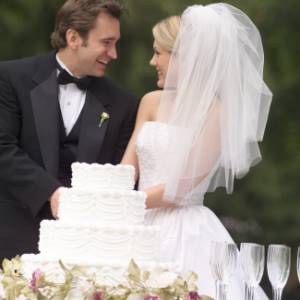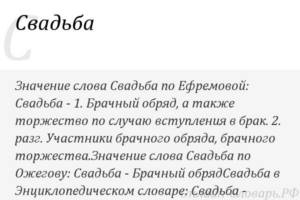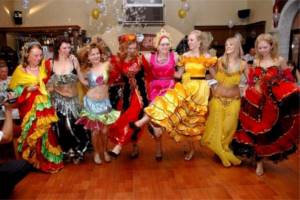The meaning of the word Wedding according to Ushakov’s dictionary:
WEDDING wedding, r. pl. weddings, w. Marriage ceremony.|| Celebration of marriage. He walked home from the wedding in the evening a little drunk. Pushkin. Celebrate the wedding. Play a wedding (region). || collected People present at the marriage celebration (region). The wedding is on its way. He will heal before the wedding (colloquial) - a humorous consolation to someone who has hurt himself or cut himself. For Malanyin’s wedding (bake, fry, cook, etc., colloquially) - there is a lot, so much that you can’t eat it all.
A wedding is a ball of love that gives happiness!
Every girl from an early age dreams of a prince who will save her from imprisonment or simply find, for example, a shoe among other girls, and they will get married and live happily. She knows that a wedding is a celebration when she will be the most beautiful princess, and everyone around will feast and have fun...
It can be assumed that from a female point of view, a wedding is, first of all, a celebration of love and the union of two halves into one, an event that marks the beginning of a happy family life. A life in which she realizes herself as a wife and mother, which means she will fulfill her main purpose.
What is a wedding for a girl in one day? Of course, this is a luxurious wedding dress, exchange of wedding rings, launching white doves into the sky, posing in front of the camera lens - in a word, a fabulous day of love and beauty.

The meaning of the word Wedding according to the Brockhaus and Efron dictionary:
Wedding (ethnogr.) - that’s what everyone calls it.

, or wheat porridge, prepared in a ceremonial manner.
this is the oldest form of bread sacrifice.
There is
next to kishkek .
bun
is also remarkable , as a remnant of a hair sacrifice.



gub., in Germany), 24) feigned beatings and tearing of braids, 25) guarding the bedchamber of the young armed. Many rituals and songs are reminiscent of the ancient sale and purchase of a bride, which was replaced among cultural peoples by the mutual consent of the young. The purchase includes all forms of marten ransom, at least in the form of the modern German Biergeld, “der Braut zu Ehren.” The S.-purchase includes: 1) bargaining and drinking of the bride, 2) sale of the braid, 3) shaking hands, 4) putting a coin to the bride’s forehead, 5) ransoming the chest, 6) ritual substitution of the bride, 7) joining the hands of the young, in the sense transferring the girl into the ownership of the groom. A special group of wedding rituals and songs are those symbolizing the subordination of a woman to a man: hitting the bride with a whip, taking off the shoes of the young man (mentioned already in the Laurentian Chronicle in 980), etc. In wedding songs and rituals (mostly Korovai) the memory of the ancient cult of the Sun is preserved: An important role in the north is played by ancient symbols of the Sun—a wreath, a candle, and round bread. In ancient life, in order to appease the patron gods of marriage and win them over in favor of the newlyweds, they were offered refreshments. Objects and methods of feeding the gods changed with the development of culture, in accordance with the local conditions of home life and the degree of prosperity of those entering into marriage. Under the dominance of shepherd life, sacrifice to the gods consisted of the slaughter of animals, mainly cows, and a libation of milk. With the development of agricultural life, the sacrifice of bread began to prevail. In desert and wooded places, crude forms of sacrifice were retained longer than in countries that were richer in nature or located along a busy water trade route. Rich people, even during the period of agricultural culture, preferred to sacrifice animals, especially large ones, on special occasions - even in large numbers (hecatombs). Poor people inevitably limited themselves to sacrificing small animals, most often a rooster. but since the sacrifice of a cow in some cases was considered necessary due to religious and mythical ideas associated with this animal, the custom arose of sacrificing an image of a cow made of dough. The sacrifice of bread itself went through several stages of development, in accordance with the methods of preparing grain food. At the lowest level of agricultural culture, either grains of bread, more or less toasted, or bread gruel, that is, the same toasted grains of bread, only crushed and moistened with water, were used for food, and, consequently, for sacrifice. Intoxicating drinks were also sacrificed - soma among the Hindus, gaoma among the Iranians, grape wine among the Greco-Italians, beer and honey among the Germans and Slavs. Important sacrificial items also included the hair of a child or newlyweds. Hair was brought in the sense of pars pro toto (part instead of the whole). in its internal meaning, this is a direct replacement for human sacrifice, immediately following the era of cannibalism. A remnant of this custom is the circumcision or trimming of the bride's braids before the wedding. In wedding songs and rituals there are direct indications that the sacrifice was accompanied by the following solemn actions: they rose and fell, placed their right hand on the newlyweds, turned to the right side, observed a circular movement or dance, which, at an increased tempo, led to a bacchanalian religious ecstasy. The offering of food and drinks to the gods was accompanied by prayers and hymns. The content of the pagan prayer was close to a conspiracy: it had a poetic form and was sung by one person or a whole assembly of worshipers. In ancient times, many wedding songs were prayers addressed to the patron gods of marriage and contained a request from the newlyweds and their entire family to send them wealth and childbearing. There were a special kind of religious songs (certa et solemnia verba of the Romans), free from narrow utilitarian goals. They glorified the marriage of the Sun and the Earth, or the Sun and the Moon, the month and the evening star, as a sacred prototype of human marriage. There was no sharp dividing line between prayers and religious songs. a religious song in honor and glory of the gods easily turned into a prayer request for the sending of earthly blessings, as, by the way, can still be seen today in carols, where the glorification of the Sun and the month successively turns into the glorification of the householder and his wife. Music for weddings. rituals in ancient times had no independent meaning and served as an accompaniment to singing. In addition to the cult of the Sun, the wedding ritual of the Slavic peoples retained the cult of the hearth, features of arboreal animism and veneration of water sources. The prominent position of the Sun in the wedding rites of the Slavic peoples was due to their devotion to agriculture. The religious and mythical elements of S. are better preserved among some Slavic peoples, and less well among others. The Southeastern Slavs turned out to be more conservative in this regard than the Western Slavs. See monographs by Mr. Yaschurzhinsky (in “Russian Phil. Vestn.” 1880 and separately). Sumtsova, “Oh wedding. rituals, mainly Russians" (dissertation, 1881), "On religious-mythical. meaning minor. WITH." (“Kyiv., Starina”, 1885), “On the influence of Greco-Roman. wedding ritual" (ib., 1886). F. Volkov, “Rites et usages nuptiaux en Ukraine” (in “Anthropologie”, II et seq. - a large and valuable study). Dovnar-Zapolsky, “O Belor. WITH." (in “Ethnogr. Review” - also extensive and valuable research). Okhrimovich, “On reflections in Little Russia.” S. ancient patriarchy" (ibid. The study is large, but one-sided and with exaggerations). For studying Great Russian and Belarusian languages. S. is best provided by the collections of Shein, Tereshchenko (“Life of the Russian People”), “Ethnogr. Collections" ed. geographer. generally, collections of Dobrovolsky and Romanov. Very detailed. and a valuable bibliographer. index of numerous collections of weddings. songs, see “Customary Law” by Yakushkin (I-II). Oh little Russian. S. extensive materials in the collection. Chubinsky (“Proceedings of Ethn. Stat. Exp.”, IV vol.), Golovatsky (“Galician songs”), Ivanov (“Life and creative cross. Kharkiv province.” 1898), Grinchenko in Sh. t. “Ethnogr. . Material.”, in “Osnova” 1862, IV, “Kyiv. Star." 1883, II, 1896, XI. Bibliography of minors. wedding dog. and rituals in the III volume “Ethnogr. Mater." Grinchenko and partly to “Kyiv. Star.”, 1896, XI (in the editor’s note to Yaschurzhinsky’s article about Malor. S.). About Bulgarian. S. in “Collected. for people Utv." (I - XV) and in the collections of Verkovich, Kachanovsky, Cholakov, Karavelov, Knyazhesky, br. Miladinov. About Serbian S. in Glasnik (1867, V). Kanitz, "Serbien". Rajajaczich, “Das Leben d. S ü. dslawen." - Polish S. in plural. volumes of “Lud” by Kohlberg, in the journal. "Wisla", Wojcicki, "Piesni" Sidi, in the newest collection. Fedorovsky. Czech S. in various magazine books “Č.esky Lid” (see weather indicators), “Kulda”, “Swadba”, “Č. asop. č. esk. Musea" (1859, I), Gumlork - "Staro č.. obyc." (I), Erben - “Prost. č.es pis." Among other materials, the collection of ancient Indian wedding hymns of Winternitz, Rosbach's study of the ancient Roman S., Mater, O Svad, are very valuable. usual and a dog. Caucasian peoples in the XXV volumes “Collected. mater. for study Caucasus". In the special study of wedding songs and rituals, general scientific works on family history are also important - Morgan, Bakhoven, M. Kovalevsky, Engel, Zagorovsky (“On Divorce”) and others. N. Sumtsov.
Wedding (legal) is the final act of marriage, giving the latter full legal force. In modern law, S. in this legal sense coincides with the concept of wedding
(cm.).
Wedding ceremonies are currently not legal, but everyday acts. Before the establishment of church forms of marriage - in Western Europe and Russia, and now - among peoples at the lowest level of culture, and partly in Russian customary law, marriage was divided into several independent acts. The most important of them were the abduction of a girl (later - a marriage contract with her parents or guardians. See Betrothal) and carnal copulation, and after the formation of the contractual form - the act of ceremonial transfer of the bride to the groom, intermediate between the contract and copulation. The legal force of these three acts at different times, apparently, was not the same. Only at a very ancient stage did abduction and copulation, and then contract, transfer and copulation coincide in one legal act, directly following each other. When the marriage became a bride purchase or an agreement to buy her from her parents, and the price for the girls was still high, it could not be paid immediately. in the contract, it was only promised in a solemn form (the old formal contract). In accordance with this, the transfer of the girl was delayed until the price was paid. S., thus, separated from betrothal (see), the legal force of which was still protected by law for a long time, preferably before the moment of S. In the latter, two acts continued to be combined: the transfer of the girl to the groom and carnal copulation. Later, these acts were also divided, and medieval jurists argued a lot about which of them should be given decisive legal force. The latest research points to a connection between the meaning of various legal aspects of the law and the property relations of the spouses. When the bride began to be endowed with a dowry and especially real estate, the transfer of the latter took place, naturally, at the time of the final transfer of the bride. in this regard, the predominant legal force passed to the second moment of S. (transfer of the girl). In those areas where marriage created a complete community of property, the rights of the wife were finally established along with the establishment of full carnal intimacy, as a result of which carnal intercourse received the greatest power in marriage law. In many localities, the final rights of the community were established - and in some places (other rights) are still established - by the successful result of cohabitation, that is, the birth of a child. And after the formation of the church form of marriage, the indicated three moments of marriage and two moments of marriage still differed in their legal force. Now the moment of the wedding in a church marriage and the performance of official solemn forms in a civil marriage have absorbed all other moments. The legal history of S. is best developed from the monuments of German law, on the basis of which the indicated evolution of S. is restored. See Schr ö. der, “Deutsche Rechtsgeschichte” (3rd ed.). Heusler, “Institutionen des deutschen Privatrecht” (II). Lehmann, “Verlobung und Hochzett nach den nordgermanischen Rechten”, as well as literature under the following words. Engagement. V.N. _
_
A wedding is the threshold of another life, full of responsibility and obligations.
Men, with their characteristic pragmatism, do not attach much importance to the series of events of this solemn day, but the meaning of the wedding is of great importance to them! They don’t have to worry at all about what kind of ribbons the wedding procession will be decorated with, which of the young people will be the first to step on the towel of consent, and they won’t hesitate for long in choosing a wedding suit. What is a wedding for them? This is a serious decision to take responsibility for starting a family, this is a promise to remain faithful, take care of and provide for this family, a decision that was made long before the holiday date, and therefore, meaningfully and consciously, that is, morally experienced. Therefore, among the strong half of humanity there is an opinion that a wedding is noisy, bright festivities in the circle of relatives and friends who share with the newlyweds the joy of their important event. By the way, you can learn more about the traditions and scale of these very festivities on the website Svadbaholik.Ru.
Definition of the word “Wedding” according to TSB:
Wedding - rituals accompanying marriage. In the early stages of social development - during the period of the maternal-tribal system, it was a simple ceremony. S. as a ritual formalization of marriage received special development during the period of Patriarchy, when monogamy (see Monogamy) and the settlement of spouses in the husband’s house (Patrilocal marriage) were firmly established. The main point of the cycle of wedding rituals among all nations is the transition (most often the move) of the bride from her parents’ house to the groom’s house, i.e., a dramatized image of a woman’s transition to a new family, a new clan. This act, as a rule, is accompanied by the exchange of gifts, a festive feast, entertainment, etc. Relatives of the bride and groom and special ritual persons (for example, matchmakers, groomsmen) participate in the ceremony. The content of these rituals is different. The forced abduction of the bride by the groom and his friends, the resistance of the bride and her relatives, etc. are often staged, which reflects that period in the history of marriage when a new (compared to the previous time) order of patrilocal settlement and the subordination of women to the authority of the husband and his relatives was established . During the period of the collapse of the patriarchal system, when payment was demanded for a woman who was considered as labor force (Veno among some European peoples, Kalym among the Mongolian and Turkic peoples, etc.), staging of the “sale” of the bride appeared in wedding rituals, and at the same time “Bridesmanship” arose - a ritual of examining the “bought” woman. Many wedding rituals are associated with religious ideas, have a magical meaning, are designed to protect the newlyweds from “evil spirits”, “damage”, etc. Among many peoples, for example, the Caucasus, mountainous Tajikistan, Gorno-Badakhshan Autonomous Okrug and other places where pre-revolutionary times there was a religious veneration of fire and the hearth (the patron of the home); the transition of a woman from one family to another was accompanied by the bride’s farewell to the hearth of her parents’ home and her dedication to her husband’s home. Grain, flour, hops, nuts, etc., which are showered upon young people in the Northern Slavic, Caucasian, and many other peoples, symbolize abundance, well-being, etc. Along with the developed ritual cycle, ritual costumes for the bride, groom, and others arose. participants of S. Each nation at a certain stage of its development is characterized by a traditional stable complex of wedding rituals, combined with all types of folk art (theatrical performances, music, singing, dancing, games). Developed religious cults usually include a religious wedding rite in the wedding complex, without displacing folk rituals, the original meaning of which is often forgotten and becomes a tradition. In a socialist society, marriage is freed from both church and, to a large extent, outdated ancient rituals associated with religion and superstition, and becomes a holiday celebrating the emergence of a new socialist family. In the USSR in the 1960-70s. The tradition of solemn registration of marriage in Wedding Palaces or in the Halls of Solemn Registration of Marriages received special development. Lit.: Kagarov E., Composition and origin of wedding rituals, in the book: Sat. Museum of Anthropology and Ethnography, vol. 8, Leningrad, 1929. Materials on the wedding and family-tribal structure of the peoples of the USSR, Leningrad, 1926. Nikolsky N. M., Origin and history of Belarusian wedding rituals, Minsk, 1956.

In Vasmer Max's dictionary
Ukrainian wedding wedding, svayba, blr. wedding, other Russian, Russian-tslav. wedding (Izborn. St. 1076), Bulgarian. matchmaking, Serbohorv. wedding, Slovenian svȃdba, Czech, Slvts. svadba, Polish swadźba, n.-luzh. swajźba, swajba. From matchmaker, actually “matchmaking”; see Sobolevsky, Lectures 104; Mi. EW 332. Unacceptable due to Russian-Tslav. evidence of rapprochement with lead, lead, contrary to Zheltov (FZ, 1876, issue 1, p. 20). People's also welding under the influence of welding “to quarrel” (Appel, RFV 3, 87).
Do you need a stamp in your passport?

Do you need it? Depend for the rest of your life on a person you don’t even love? Sell your smile, your attention, your body, your actions and love for money? Do you think that money is the highest value in life? Then I feel sorry for you, because there is nothing more valuable than love and happiness next to your loved one. If then, after many years or even decades, you subtract empty chatter, clothes, money and expensive toys from your life, will there be anything worthwhile left in it? Or just a broken trough and life as many unused chances to be happy?
After all, as wise people say, the ideal lover is a man, next to whom you understand the meaning of the word “fidelity.” And a wedding, marriage registration is needed precisely by those people, women and men, who are lucky enough to know true love and meet an ideal partner - they already know the meaning and price of fidelity, and therefore they only want to be close to their loved one, they want to live with him and love him openly and for a very long time.
If weddings were really not needed, then people would not have weddings, would not register their love and their close relationships. But every third or even second lover and loving person who has not yet united his life with the life of his beloved by marriage is interested in wedding issues to one degree or another. And these are not just words, but dry statistics: in Yandex, 3 million people were interested in love in July 2009, and 1.5 million Internet users were interested in weddings.
And one more thing: no matter what the advocates of civil marriage and open relationships say, it is impossible to live out of suitcases all your life and wait for the wind of change. Because of your youth and stupidity, you can throw yourself down the drain for ten years, following the lead of changing public opinion regarding the advisability of civil marriages and the advisability of a traditional wedding.
But sooner or later, every person wants basic stability, confidence in the future and their loved one. It is impossible to spend your whole life looking for another, and even better and ideal partner: after all, people do not get younger or more beautiful with age, and their strength does not increase. Therefore, the decision to start a family and have a wedding with a loved one is the decision of adults who have already had their fill of free love and who have come to the conclusion that there is nothing better in the world than to be tied as tightly as possible to the body by legal formalities and the soul of a loved one.
If you have been looking for the right person for ten years and still can’t find it, then this is a serious reason to think - do you know what you are looking for? Do you know yourself and your desires? Because there are always a lot of suitable people around, but to find them, you need to know what exactly you are looking for in a person. And the list of requirements for the chosen one should be short - no more than 3 main points and relate not to appearance, but to his internal qualities. For example, a win-win option for a woman when she wants to meet a kind and smart man.
A wedding is a kind of “book of complaints and wishes” about family life!
Agree, a wedding is like a play: after all, events go according to the script, the scenery changes, the crowd works, a variety of scenes are played out. And this game is performed brilliantly by all participants in the celebration - relatives and invited guests. What is a wedding through their eyes? What and why do they go to the wedding? The first thing is, of course, to congratulate the newlyweds, share the joy with them and become part of their grand celebration! But take a closer look at what they do throughout the celebration, proclaiming toasts and wishes, playing various situations from life and inviting the newlyweds to make choices, look for solutions, etc.? After all, they give them parting words, good advice and share their experience in order to protect the young family from problems and mistakes...

Critic's opinion[edit]
Some scenes in the original script, written by Alexander Galin, differed from what was filmed by Lungin. But the thing is that Lungin specially attracted quite a large number of non-professional actors to work on the film - ordinary residents of those same Lipki - who, as Lungin himself admitted, influenced the course of filming so much that Lungin even had to change the script somewhat. Moreover, these ordinary residents of a decaying mining town played so brightly that it was not always possible to distinguish where the professional actors were and where they were just extras, which probably prompted the jury of the Cannes Festival to give the film the prize “For Best Acting Ensemble”.
The ensemble there is really excellent, although the actors look quite different. To be honest, I didn’t really like the main characters - Marat Basharov and Maria Mironova - and didn’t remember anything special about them. But in the film there are several supporting actors (however, they are “background” in terms of the plot, but in terms of the complexity of their roles and the frequency of appearance on the screen, they can easily qualify for the “foreground”), who played simply brilliantly.
Perhaps the most memorable is Garkusha performed by Andrei Panin. Garkusha, as you remember, is the main drunk and the main troublemaker. According to the plot, he is assigned a rather important role: he is the unwitting culprit of big troubles that happen to the groom, but he does everything to ensure that the groom avoids these troubles. Panin plays just fine, and his Garkusha is one of the most interesting roles in the film.
The second most important and vivid role is the policeman Borzov, played by Alexander Semchev (remember the fat man advertising beer in a TV commercial?). Semchev proved that his acting capabilities are not limited to commercials. In “The Wedding,” his role is extremely complex: policeman Borzov is a real scoundrel, invested with power, who, for the sake of his lousy career, is ready to commit a crime and ruin Misha’s life by “tailoring” a criminal case against him, for which Misha can easily go to prison for years. five. Moreover, Semchev paints the type of this bastard so accurately that very similar characters immediately appear before my eyes, which I have repeatedly observed in real life: a policeman in a small town, who knows almost every resident by name, who attends all family celebrations, who drinks vodka with these people , sings songs, dances with them, but can sell anyone for a pittance if it helps his promotion.
Some critics reproached Lungin for the fact that Borzov seemed to have reformed at the end of the film. We watched the movie inattentively, fellow critics, Borzov did not improve at all. He remained the same as he was - a bastard in power. He was simply driven to hysterics, and so he lost his temper: he could not bring his villainy to the end. In addition, there was a wedding, songs, vodka, and the boss got drunk... So Borzov temporarily became better. But don't worry! These little people don’t suddenly change their lack of principles for principles. He'll sleep it off and everything will pass.
And the third role, which is very memorable, is that of a noble miner, Misha’s father. The role is episodic, but every appearance of Salnikov is simply brilliant. A very interesting character: on the one hand, he is quite gentle (he calls Misha “son”, which is not very typical for the harsh environment of miners), but on the other hand, dad is so worried about his son and is so rooting for the wedding to go smoothly and everything was “like people”, that it’s better not to get in dad’s way - he’ll trample.
“The aunt from Kharkov” also plays excellently, who does something unimaginable in the scenes with Garkusha... however, that’s enough to list, because there are so many interesting roles that we could talk about them for days.
In short, I liked the film. There are certain shortcomings in it that somewhat blur the impression, but I don’t want to talk about them, because in general, the film is good. The cast is truly magnificent, and the film received the prize at Cannes completely deservedly.
Lungin made a true and life-like film. Moreover, one gets the impression that it turned out to be true not even thanks to, but despite the script, in which, in my opinion, a lot of things were made up “out of context.” But Lungin himself said that it was the residents of Lipki who to a certain extent influenced how the film ultimately turned out, which means that life itself made its own adjustments to the picture.
Should I watch it? Of course it is necessary. It's not a masterpiece, but it's a very solid movie that features a really great ensemble cast and some stellar performances. Contrary to the opinion of some critics, this is not at all a “cranberry a la Russe” filmed by Lungin for the West. Therefore, in Russia the film will look no worse than in Cannes. And if we take into account the fact that in Russia now good films appear almost once a year (there are almost no new “masters”, and the old ones are an order of magnitude more often disappointing than pleasing), Lungin’s “Wedding” should become a real event.[1 ]











